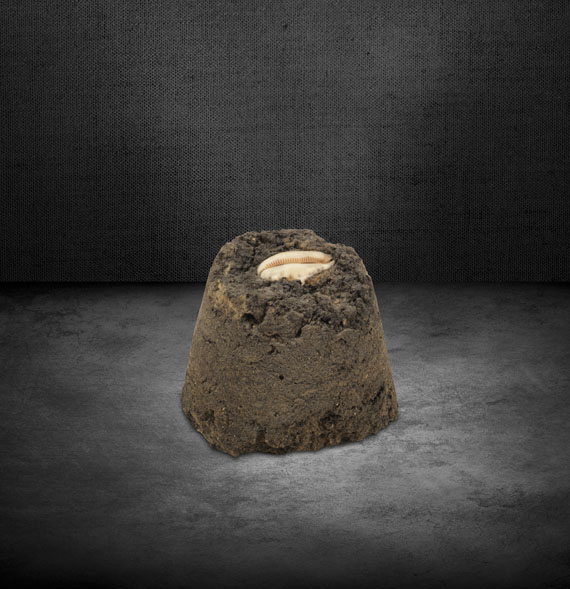356
Joseph Beuys
Erdobjekt "TA...KA-(TURM)", 1975.
Erdobjekt, Muschel
Estimate:
€ 70,000 / $ 82,600 Sold:
€ 87,500 / $ 103,250 (incl. surcharge)
Erdobjekt "TA..KA-(TURM)". 1975.
Erdobjekt, Muschel.
Signed, dated and titled on a note below the object. (Not visible due to mounting). Height: 15 cm (5.9 in). Plexiglass box: 25,5 x 27 x 27 cm (10 x 10,6 x 10,6 in).
The object is made of African soil. [EH].
• Soil is one of Beuys' most important materials.
• For Joseph Beuys soil is a condensed material of the origin, a generator of formative power.
• Earth objects like the "Erdtelefon" (1967) or "Erdhaufen und elektronisches Gitter" (1957) count among Beuys’ most famous works.
• Earth objects by Beuys are very rare on the market.
• Significant earth objects are also part of the Block Beuys at Landesmuseum Darmstadt and the Museum Schloß Moyland.
Accompanied by a written confirmation from Eva Beuys dated February 14, 2019 (in copy).
PROVENANCE: The artist's studio (Drakeplatz 4).
Private collection Germany (acquired directly from the artist).
EXHIBITION: Joseph Beuys: Natur Materie Form, ex. cat. Kunstsammlung Nordrhein-Westfalen, Düsseldorf, November 30, 1991 - February 9, 1992, cat. no. 419 (with illu. on p. 334).
Joseph Beuys: Wo ist Element 3?, Ketterer Kunst, Berlin, March 26 – May 22, 2021.
Erdobjekt, Muschel.
Signed, dated and titled on a note below the object. (Not visible due to mounting). Height: 15 cm (5.9 in). Plexiglass box: 25,5 x 27 x 27 cm (10 x 10,6 x 10,6 in).
The object is made of African soil. [EH].
• Soil is one of Beuys' most important materials.
• For Joseph Beuys soil is a condensed material of the origin, a generator of formative power.
• Earth objects like the "Erdtelefon" (1967) or "Erdhaufen und elektronisches Gitter" (1957) count among Beuys’ most famous works.
• Earth objects by Beuys are very rare on the market.
• Significant earth objects are also part of the Block Beuys at Landesmuseum Darmstadt and the Museum Schloß Moyland.
Accompanied by a written confirmation from Eva Beuys dated February 14, 2019 (in copy).
PROVENANCE: The artist's studio (Drakeplatz 4).
Private collection Germany (acquired directly from the artist).
EXHIBITION: Joseph Beuys: Natur Materie Form, ex. cat. Kunstsammlung Nordrhein-Westfalen, Düsseldorf, November 30, 1991 - February 9, 1992, cat. no. 419 (with illu. on p. 334).
Joseph Beuys: Wo ist Element 3?, Ketterer Kunst, Berlin, March 26 – May 22, 2021.
In December 1974 the photographer Charles Wilp invited Joseph Beuys and his family to a photo session in Diana on the Kenyan coast. Apparently Beuys returned home with Kenyan soil which he kept in a flower pot. So far, the designation "TA… KA- (Turm)" has not been fully unlocked. It is certainly daring to think of Astrid Lindgren's children's book "Pippi in Taka-Tuka-Land" (Pippi in the South Seas), however, Beuys repeatedly integrated the toys of his children into his installations, for example in the showcases at the "Block Beuys" at the Hessian State Museum in Darmstadt. Or he used the sounds his son Wenzel made while learning to speak as titles for his works, such as it is the case with "Kukei, akopee - No!". (Uwe M. Schneede, Joseph Beuys, die Aktionen, Stuttgart 1994, no. 4, p. 42). In Lindgren’s book Pippi’s father lives as a king in Africa, where he is held captive in a tower on Taka-Tuka Island. On top of our "tower" is a cowry snail (Cypraeidae) that also commonly occurs in Africa. Their shell were used as currency, because of the porcelain-like surface, which appeared to be valuable, so slaves in West Africa were traded for cowry money. Beuys‘ last large work "Palazzo Regale" from 1985, which is now part of the Kunstsammlung Nordrhein-Westfalen in Düsseldorf, also has a giant sea snail (Cassis Tuberosa cornuta) in one of the showcases. Soil as a substance plays an important role for Beuys, for example in the work "Erdtelefon" from 1968, which suggests a possible conversation with the Earth. [Eugen Blume]
356
Joseph Beuys
Erdobjekt "TA...KA-(TURM)", 1975.
Erdobjekt, Muschel
Estimate:
€ 70,000 / $ 82,600 Sold:
€ 87,500 / $ 103,250 (incl. surcharge)
Headquarters
Joseph-Wild-Str. 18
81829 Munich
Phone: +49 89 55 244-0
Fax: +49 89 55 244-177
info@kettererkunst.de
Louisa von Saucken / Undine Schleifer
Holstenwall 5
20355 Hamburg
Phone: +49 40 37 49 61-0
Fax: +49 40 37 49 61-66
infohamburg@kettererkunst.de
Dr. Simone Wiechers / Nane Schlage
Fasanenstr. 70
10719 Berlin
Phone: +49 30 88 67 53-63
Fax: +49 30 88 67 56-43
infoberlin@kettererkunst.de
Cordula Lichtenberg
Gertrudenstraße 24-28
50667 Cologne
Phone: +49 221 510 908-15
infokoeln@kettererkunst.de
Hessen
Rhineland-Palatinate
Miriam Heß
Phone: +49 62 21 58 80-038
Fax: +49 62 21 58 80-595
infoheidelberg@kettererkunst.de
We will inform you in time.




 Lot 356
Lot 356 
